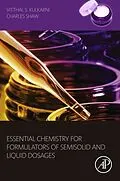A needed resource for pharmaceutical scientists and cosmetic chemists, Essential Chemistry for Formulators of Semisolid and Liquid Dosages provides insight into the basic chemistry of mixing different phases and test methods for the stability study of nonsolid formulations. The book covers foundational surface/colloid chemistry, which forms the necessary background for making emulsions, suspensions, solutions, and nano drug delivery systems, and the chemistry of mixing, which is critical for further formulation of drug delivery systems into semisolid (gels, creams, lotions, and ointments) or liquid final dosages. Expanding on these foundational principles, this useful guide explores stability testing methods, such as particle size, rheological/viscosity, microscopy, and chemical, and closes with a valuable discussion of regulatory issues. Essential Chemistry for Formulators of Semisolid and Liquid Dosages offers scientists and students the foundation and practical guidance to make and analyze semisolid and liquid formulations. - Unique coverage of the underlying chemistry that makes possible stable dosages - Quality content written by experienced experts from the drug development industry - Valuable information for academic and industrial scientists developing topical and liquid dosage formulations for pharmaceutical as well as skin care and cosmetic products
Autorentext
Vitthal Kulkarni, Ph.D. is Scientific Advisor at DPT Laboratories San Antonio, Texas. After earning Ph.D. in Chemistry at National Chemical Laboratory, Pune, India in the area of surface/colloid chemistry, Dr. Kulkarni studied lipid monolayers, bilayers, self-assembled nano-structures, and protein electron crystallography at various institutions including Université de Provence, Marseille, France, JEOL Ltd., Tokyo, Japan, Vanderbilt University, Nashville, Tennessee, University of Minnesota, Austin, Minnesota and Yale University, New Haven, Connecticut before moving into industry. Dr. Kulkarni has been with DPT Laboratories since 2003.
Dr. Kulkarni is experienced in developing and characterizing various non-invasive drug delivery systems including topical drug delivery systems comprised of liposomes, and nano-particles, emulsions and nasal spray products. He has published scientific research articles in peer reviewed journals, patents, book chapters, and edited a book titled Handbook of Non-Invasive Drug Delivery Systems: Science and Technology. He is a current member of American Association of Pharmaceutical Scientists.
Klappentext
A needed resource for pharmaceutical scientists and cosmetic chemists, Essential Chemistry for Formulators of Semisolid and Liquid Dosages provides insight into the basic chemistry of mixing different phases and test methods for the stability study of nonsolid formulations. The book covers foundational surface/colloid chemistry, which forms the necessary background for making emulsions, suspensions, solutions, and nano drug delivery systems, and the chemistry of mixing, which is critical for further formulation of drug delivery systems into semisolid (gels, creams, lotions, and ointments) or liquid final dosages. Expanding on these foundational principles, this useful guide explores stability testing methods, such as particle size, rheological/viscosity, microscopy, and chemical, and closes with a valuable discussion of regulatory issues. Essential Chemistry for Formulators of Semisolid and Liquid Dosages offers scientists and students the foundation and practical guidance to make and analyze semisolid and liquid formulations.
- Unique coverage of the underlying chemistry that makes possible stable dosages
- Quality content written by experienced experts from the drug development industry
- Valuable information for academic and industrial scientists developing topical and liquid dosage formulations for pharmaceutical as well as skin care and cosmetic products
Inhalt
1. Introduction to the Chemistry of Mixing
2. Surfactants, Lipids and Surface Chemistry
3. Drug Delivery Vehicles
4. Formulating Creams, Gels, Lotions and Suspensions
5. Polymers and Thickeners in Semisolid Formulations
6. Topical Aerosol and Nasal Sprays
7. Formulation and Stability Testing
8. Particle Size: An Overview of Various Methods
9. Rheological/Viscosity Studies
10. Microscopy Techniques (Optical and Electron Microscopy)
11. Miscellaneous Physical, Chemical and Microbiological Test Methods
12. An Overview of Regulatory Aspects for Pharmaceutical Semisolid Dosage
